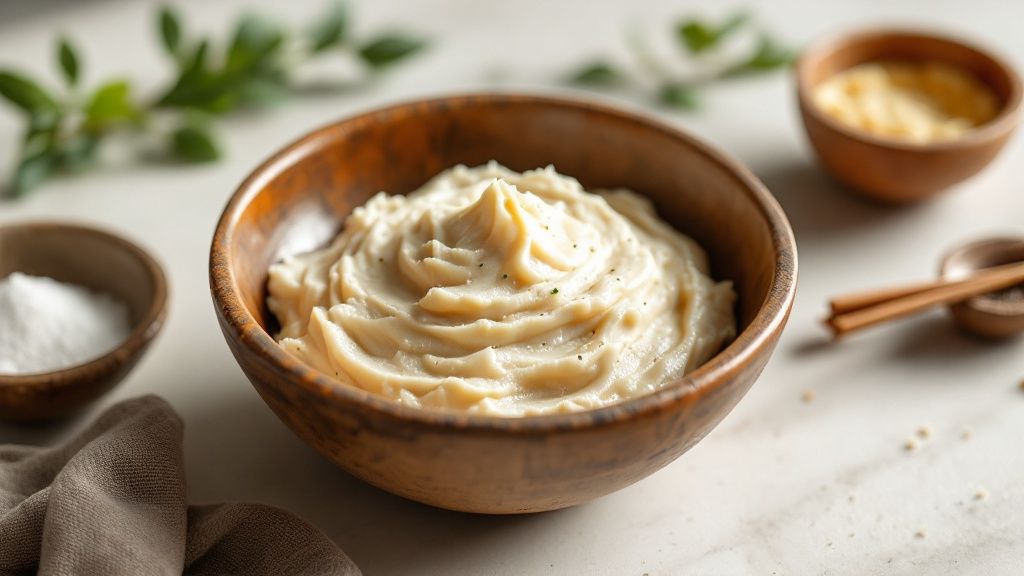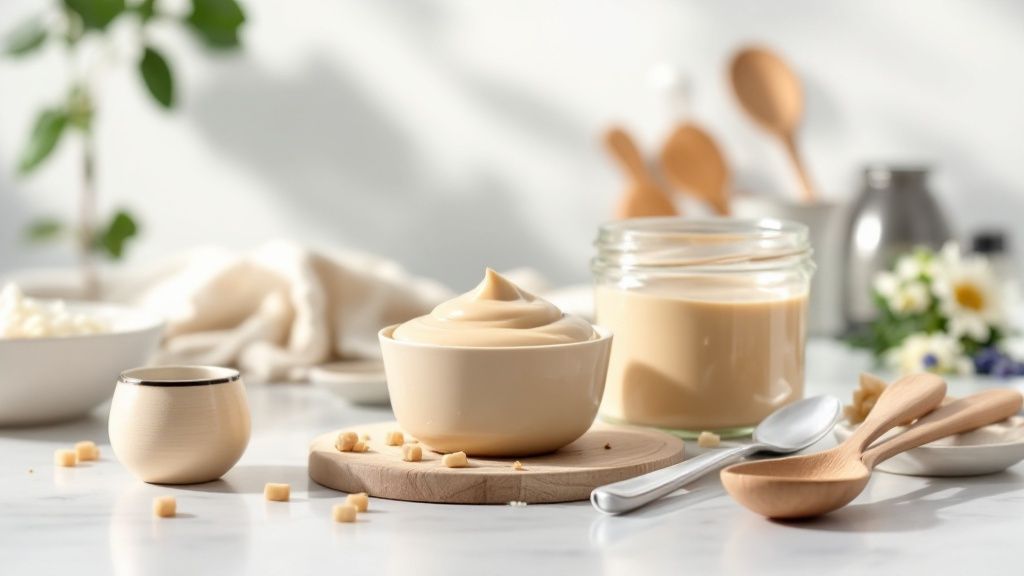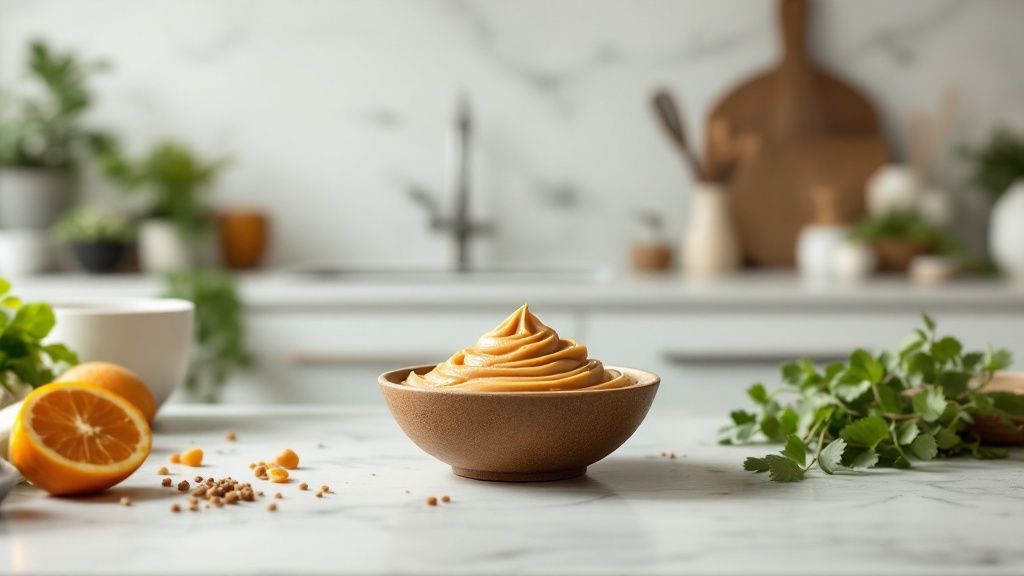Why Low Sodium Miso Paste Is Changing the Culinary Game

For many, the rich, savory depth of miso paste is a cornerstone of delicious cooking. However, the traditionally high sodium content has been a hurdle for those watching their salt intake. That's where low sodium miso paste enters the picture. It offers all the flavor without the compromise.
This allows cooks to enjoy the complex umami of miso while still managing their sodium levels. This move towards healthier ingredients is changing how we think about cooking, especially for those seeking flavor and health in equal measure.
The Rise of Health-Conscious Cooking With Miso
The increasing popularity of low sodium miso paste reflects a larger trend: people are prioritizing health but refusing to sacrifice taste. Traditional miso, while flavorful, can be too salty for some palates. Low sodium versions offer a welcome alternative, broadening access to the unique taste of miso.
This means dishes retain their authentic profiles while meeting individual dietary needs. The growing demand for low sodium miso paste also speaks to a global shift towards balanced eating. This demand is rising globally, fueled by health-conscious consumers who want to reduce sodium without losing the benefits of fermented foods.
Between 2025 and 2035, the global miso paste market, including low sodium options, is expected to grow at a CAGR of 3.5%, reaching a value of USD 567 million by the period's end. This growth points to the increasing interest in healthier eating and plant-based diets, with miso paste as a versatile flavor enhancer. Learn more about this culinary shift: From Japan to the World: The Rising Popularity of the Miso Paste Market. You might also enjoy: Exploring Japanese products.
Balancing Flavor and Wellness
Low sodium miso paste offers a remarkable balance of flavor and wellness in the kitchen. This is achieved through careful adjustments to the traditional fermentation process. Manufacturers have found ways to lower the sodium without impacting the signature umami taste.
This intricate process involves precise control over fermentation time and ingredients. The result? A product that's both flavorful and health-conscious. This empowers chefs and home cooks to create dishes that are delicious and support a healthy lifestyle.
Expanding Culinary Possibilities
The versatility of low sodium miso paste is another factor contributing to its popularity. It can be incorporated into a wide array of dishes, from soups and marinades to dressings and glazes. The ability to add depth and complexity without excessive salt makes it an essential ingredient for today's cooks.
Think of it as a secret ingredient to boost flavor without the health drawbacks. This adaptability unlocks exciting new ways to use miso in various cuisines and dietary plans, solidifying its position as a culinary innovator.
The Surprising Health Benefits You're Actually Getting

Low sodium miso paste isn't just about reducing salt intake. It's a flavorful ingredient packed with surprising health advantages. This fermented powerhouse offers benefits far beyond simple sodium reduction. It can improve your gut health, provide essential nutrients, and contribute to cardiovascular well-being. Let's delve into these advantages.
A Boost For Your Gut
Low sodium miso paste is a rich source of probiotics. These are the beneficial bacteria that contribute to a healthy gut microbiome. A balanced gut microbiome is linked to improved digestion and a potential boost to your immune system. The live cultures, a result of the fermentation process, play a vital role in overall wellness. This makes low sodium miso a great addition to any diet focused on gut health.
Nutrient-Rich and Delicious
Even with less sodium, low sodium miso paste retains a robust nutritional profile. It's full of essential nutrients like protein, B vitamins, and various minerals. This makes it a nutritious and flavorful way to enhance your meals.
- Soups
- Marinades
- Even desserts
You're not just adding flavor; you're adding a healthy dose of vital nutrients.
Heart-Healthy Choice
Choosing low sodium miso paste is a smart move for a heart-healthy lifestyle. Reducing your sodium intake helps maintain healthy blood pressure levels – crucial for cardiovascular health. The probiotics in miso may also contribute to supporting heart health. Many healthcare professionals recommend low sodium miso paste as part of a balanced diet for patients with heart health concerns. This highlights the importance of incorporating low-sodium options in your diet.
To illustrate the nutritional differences, let's take a look at a comparison table:
Nutritional Comparison: Regular vs. Low Sodium Miso Paste
Comparing the nutritional profiles of traditional and low sodium miso paste varieties to highlight differences in sodium content while showing similar benefits in other nutritional areas.
| Nutrient | Regular Miso Paste (per 100g) | Low Sodium Miso Paste (per 100g) | % Difference |
|---|---|---|---|
| Sodium | 4600mg | 2300mg | -50% |
| Protein | 12g | 11g | -8.3% |
| Fat | 5g | 4.5g | -10% |
| Carbohydrates | 20g | 19g | -5% |
| B Vitamins | Present (Varying amounts) | Present (Varying Amounts) | Similar |
As you can see, the sodium content is significantly lower in the low-sodium version, while other nutritional values remain relatively similar. This makes low sodium miso a great alternative for those watching their sodium intake.
Growing Global Demand
The demand for low sodium miso paste is increasing globally, particularly in North America and Europe. This growth is fueled by its versatility in modern cooking and increased awareness of the health benefits of fermented foods. Regions like Germany, with a strong focus on organic and natural products, are seeing a significant rise in demand for clean-label miso paste. By 2033, the global miso paste market is projected to reach USD 1.8 billion, driven by the expansion of organic and low-sodium options. You can find more details here: Miso Paste Market. This shift towards healthier food choices underscores the growing popularity of low sodium miso paste.
Finding Your Perfect Match: Top Brands Worth Trying

Not all low sodium miso pastes are the same. This guide helps you navigate the many choices and find the perfect low sodium miso paste for your needs. We'll explore flavor profiles, fermentation methods, and the best places to buy these flavorful ingredients. This information empowers you to make a smart decision and pick a miso paste that truly elevates your cooking.
Understanding Flavor Profiles and Fermentation
Different brands of low sodium miso paste offer unique flavor profiles. Some are sweeter, while others boast a more savory, earthy taste. These variations come from the type of koji used (the starter for fermentation) and the fermentation time. A longer fermentation period typically creates a richer, more complex flavor.
For example, white miso (shiro miso) tends to be milder and sweeter thanks to a shorter fermentation. Red miso (aka miso) has a bolder, more pungent taste due to longer fermentation. Traditional methods are key to the final product's quality. Seek out brands that adhere to authentic techniques for superior flavor and texture.
Navigating the Market: Where to Buy
Finding good low sodium miso paste can sometimes feel like a treasure hunt. You can often find these products in specialty Asian markets. However, some mainstream grocery chains are also beginning to stock them. Online retailers offer another convenient buying option.
When choosing a retailer, think about factors like product selection, price, and shipping options to find the best fit for you. For a wider selection of Japanese products, you might want to check out Exploring Japanese Products.
Deciphering Packaging and Shelf Life
Packaging is crucial for preserving the quality of low sodium miso paste. Look for airtight containers that protect the paste from oxidation and spoilage. Good packaging maintains freshness and extends shelf life.
Once opened, store your miso paste in the refrigerator. This slows the fermentation process and preserves its flavor, ensuring you get the most out of your purchase.
Key Considerations for Your Choice
Several factors influence your miso paste selection. Consider your culinary needs and preferences. Do you want a mild, sweet flavor for dressings or a more intense taste for marinades?
If organic certification or specific dietary requirements are important, look for brands that align with your values. Price is also a factor, but remember quality often comes at a slightly higher cost.
Top Brands to Explore
Ready to begin your low sodium miso adventure? Here are a few recommended brands to get you started:
- Hikari Miso: Known for its organic and non-GMO options.
- Miko Brand: Offers a variety of miso types, including low-sodium versions.
- South River Miso: Produces handcrafted miso using traditional methods.
This is just a starting point. Many other excellent brands are waiting to be discovered. Experiment and find the low sodium miso paste that best suits your palate and cooking style.
Master Techniques: Cooking With Low Sodium Miso Like a Pro

Using low sodium miso paste effectively means understanding how it behaves in the kitchen. This involves adjusting your cooking techniques to highlight this ingredient's unique flavor profile. Temperature control and proper dilution are especially important. Mastering these techniques allows you to create dishes that truly showcase low sodium miso's subtle characteristics.
Temperature Control: Preserving Flavor and Probiotics
Low sodium miso paste, just like regular miso, is sensitive to high heat. Too much heat can destroy beneficial probiotics and diminish the delicate flavor. That's why it's crucial to avoid boiling miso.
Instead, add it near the end of cooking. This preserves both the probiotics and the savory umami notes. Treat it like fresh herbs – you wouldn't boil them for long periods, and the same principle applies to low sodium miso.
Layering Flavors: Building Complexity Without Salt
One of the biggest challenges with low sodium miso paste is achieving depth of flavor without relying on extra salt. The secret lies in building flavor through layering. Begin by incorporating ingredients that complement miso's umami richness.
For example, try ingredients like shiitake mushrooms, kombu seaweed, or dried fish flakes (katsuobushi). These natural umami boosters work synergistically with the miso, intensifying the overall flavor without relying on sodium. A touch of acidity, such as rice vinegar or lemon juice, brightens the flavors, adding another dimension to your dish.
Dilution Techniques: Mastering Different Applications
Proper dilution is essential for using low sodium miso paste effectively. Different dishes call for different concentrations. This is especially helpful when adapting recipes originally designed for traditional, higher-sodium miso.
For soups, dilute a tablespoon of low sodium miso paste in a small amount of hot broth before adding it to the main pot. This prevents clumping and ensures even flavor distribution. Glazes and marinades often require a thicker consistency, needing less dilution. Experimenting with different dilutions unlocks low sodium miso's full potential.
Avoiding Common Pitfalls
A few common mistakes can hinder your low sodium miso adventures. One frequent issue is over-salting other parts of the dish, negating the benefits of using a low sodium ingredient. Taste as you go, adjusting seasoning carefully.
Another pitfall is using low sodium miso paste in dishes that require high salt content for preservation, such as pickles. In these cases, consider adapting the recipe or exploring alternative preservation methods for lower sodium levels. Understanding these nuances helps avoid culinary mishaps and maximizes the flavor of your dishes.
Low Sodium Miso Paste Applications Guide
This guide showcases different culinary uses for low sodium miso paste with recommended amounts and techniques.
| Dish Type | Miso Type Recommendation | Recommended Amount | Preparation Technique | Flavor Profile |
|---|---|---|---|---|
| Soup | White (Shiro) or Yellow (Awase) | 1-2 tbsp per quart | Dilute in hot broth before adding | Savory, Umami |
| Marinade | Red (Aka) or Brown (Genmai) | 2-3 tbsp per pound | Whisk with oil, vinegar, and aromatics | Rich, Intense |
| Salad Dressing | White (Shiro) | 1-2 tbsp | Whisk with vinegar, oil, and sweeteners | Tangy, Umami |
| Glaze | Red (Aka) or Brown (Genmai) | 1-2 tbsp | Simmer with mirin, sake, and sugar | Sweet, Savory |
By understanding these techniques, you'll truly be able to cook with low sodium miso paste like a pro. Explore the variety of Japanese products at Buy Me Japan to complete your culinary experience.
Beyond Soup: Unexpected Ways to Transform Your Cooking
Low sodium miso paste is more than just an ingredient for miso soup. It's incredibly versatile, offering a wealth of opportunities to elevate your cooking. This section explores how low sodium miso paste can bring depth and complexity to a variety of dishes, transforming ordinary ingredients into culinary masterpieces. These aren't just tweaked recipes; they're dishes designed specifically to showcase the distinct qualities of low sodium miso.
From Salads to Marinades: Unveiling Umami
Low sodium miso paste is your secret weapon for creating dressings bursting with umami, that savory fifth taste, without relying on excess salt. Whisk a small amount into your favorite vinaigrette and experience how it adds depth to both delicate greens and more substantial vegetables. The result? Vibrant, flavorful salads that satisfy without overdoing the sodium.
For instance, a simple vinaigrette made with olive oil, rice vinegar, and a touch of low sodium white miso creates a dressing that’s both light and packed with flavor. Low sodium miso paste also shines in marinades. Its unique flavor profile adds complexity and depth, enhancing the natural sweetness of vegetables like carrots, eggplant, and bell peppers.
Breakfast to Dessert: Exploring New Frontiers
The possibilities of low sodium miso paste extend beyond savory dishes, venturing into the realms of breakfast and dessert. Adding a small amount to pancake or waffle batter introduces a subtle savory note that balances the sweetness, creating a surprisingly delicious and complex flavor profile.
In desserts, low sodium white miso paste complements rich ingredients like chocolate or caramel. Its subtle saltiness enhances the sweetness, creating a balanced and intriguing flavor combination. You might be interested in: How to master Japanese cooking.
Recipes Crafted for Low Sodium Miso
Each recipe discussed has been meticulously developed and tested with specific low sodium miso brands to ensure consistent and delicious results. These recipes provide clear, step-by-step instructions for achieving optimal flavor balance, highlighting the unique properties of low sodium miso and delivering impressive nutritional value.
These aren't adapted recipes; they’re dishes specifically created to maximize the potential of low sodium miso. This ensures you experience the full range of what this versatile ingredient has to offer.
Focusing on Flavor and Nutrition
These recipes aim to showcase the versatility of low sodium miso paste while promoting healthy eating habits. Each dish is crafted with both flavor and nutrition in mind, resulting in exciting and satisfying meals that support a healthy lifestyle.
By prioritizing both taste and nutritional value, these recipes help you enjoy delicious food without compromising your well-being. This focus makes low sodium miso paste a valuable ingredient for anyone looking to elevate their cooking while maintaining a balanced diet. Low sodium miso paste is a true asset in any modern kitchen.
DIY Low Sodium Miso: Creating Your Perfect Blend at Home
Making your own low sodium miso paste at home puts you in control of both the flavor and sodium content. This guide breaks down the fermentation process, incorporating tips from both professional and home miso makers. We’ll explore ingredient ratios for a low-sodium approach, essential equipment, key monitoring steps during fermentation, and troubleshooting advice. Follow these guidelines to create a delicious and healthy homemade miso paste.
Ingredients and Ratios for Low-Sodium Success
Creating low sodium miso involves tweaking the standard recipe to reduce sodium while prioritizing food safety. The trick is to lower the salt without disrupting the crucial fermentation process that prevents spoilage. A typical miso recipe uses soybeans, koji (a fermentation starter), and salt. For a lower sodium version, decrease the salt by roughly 25-50% compared to a standard recipe.
For instance, if a recipe normally requires 100g of salt, use 50-75g for your low-sodium batch. Maintaining sufficient salt is critical to inhibit the growth of harmful bacteria. This balance allows beneficial microorganisms to flourish while ensuring your homemade miso is safe to eat.
Equipment Essentials for Quality Miso
Having the right equipment can significantly impact your miso-making journey. A food-grade fermentation crock is ideal. This type of crock promotes proper airflow and temperature regulation during fermentation. Ensure it's thoroughly cleaned and sterilized before use to prevent unwanted mold.
You'll also need weights to keep the miso submerged beneath a layer of protective brine. This brine shields the miso from oxygen and spoilage. Select food-grade weights that can be easily sterilized. These tools, combined with high-quality ingredients, set the stage for successful fermentation.
Monitoring and Maintaining Your Miso
Fermentation is an active process that requires careful attention. Temperature plays a crucial role. Ideally, miso should ferment at a cool room temperature, around 50-60°F. Temperature fluctuations can impact both the fermentation rate and the final flavor profile.
Regularly inspect your miso for kahm yeast, a harmless white film that can occasionally appear on the surface. Simply skim it off if you see it. However, be vigilant for colorful molds, which indicate spoilage. Careful monitoring of these factors will contribute to a high-quality final product.
Troubleshooting Common Miso Making Issues
Even with meticulous preparation, issues can sometimes arise. Uneven fermentation is a common problem. This can happen if the miso isn't packed tightly enough into the crock, creating air pockets. Ensuring a compact and even layer of miso during the initial packing process can help prevent this.
Another potential problem is mold growth. If you spot mold other than kahm yeast, the batch is likely spoiled and should be discarded. Maintaining good hygiene practices and consistently monitoring the temperature will help minimize the risk of mold.
Flavor Adjustments and Peak Maturity
After your miso has fermented for several months (typically six months to a year or more), you can taste it and adjust the flavor. If you prefer a more intense flavor, extend the fermentation time. Conversely, if it’s too salty (even with the reduced salt), blend in a small amount of cooked, unsalted soybeans.
Knowing when your miso has reached peak maturity involves both observation and taste. The color will deepen, and the flavor will become richer and more complex over time. The ideal flavor is ultimately a matter of personal preference.
Ready to delve into the world of Japanese cuisine? Discover a diverse selection of authentic Japanese food and drinks at Buy Me Japan. Embark on your culinary adventure today!




Share:
Explore Japanese Fermented Vegetables Today!
Japanese Straightening at Home: DIY Expert Tips